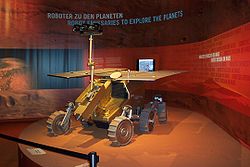Overview
Member states committed to participation in the Aurora programme for five-year periods, after which they can change their level of participation or pull out entirely. In the early years the Aurora programme planned for flagship missions and arrow missions for key technology demonstrations, such as Earth re-entry vehicle/capsule and Mars aerocapture demonstrator. Although human spaceflight has remained a long-term goal of the programme, with some basic technology development in this area, the thrust has been on implementation of the ExoMars mission and preparations for an international Mars sample return mission. [2]
"The objective of the Aurora Programme is first to formulate and then to implement a European long-term plan for the robotic and human exploration of solar system bodies holding promise for traces of life."
The Aurora programme was a response to Europe's Strategy for space which was endorsed by European Union Council of Research and the ESA Council. [6] Europe strategy for space had three main points including: "explore the solar system and the Universe", "stimulate new technology", and "inspire the young people of Europe to take a greater interest in science and technology". [6] One of the foundational principles of the Aurora program was recognising the interdependence of technology and exploration. [6] [1]
This page is based on this
Wikipedia article Text is available under the
CC BY-SA 4.0 license; additional terms may apply.
Images, videos and audio are available under their respective licenses.




